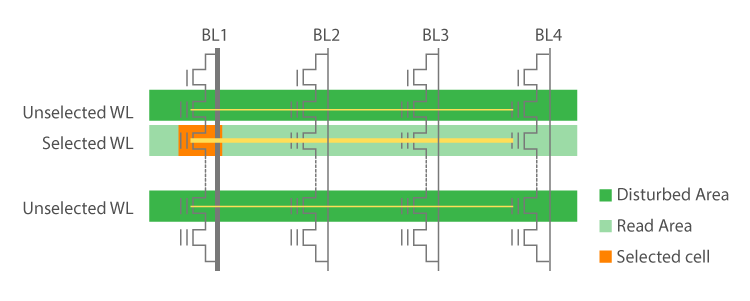Introduzione
La memoria flash NAND è una forma comune di supporti di memorizzazione, con ampie applicazioni da dispositivi mobili con form factor ridotto a storage di data center. Tuttavia, dal momento che le moderne celle flash sono continuamente ridimensionate, il problema dei disturbi della lettura sta diventando uno dei principali fattori che tengono conto dei problemi di affidabilità riscontrati nelle memorie flash NAND. Un problema di disturbo della lettura, in breve, si verifica dopo che una grande quantità di attività di lettura viene eseguita su pagine all'interno dello stesso blocco, causando la modifica dei valori digitali delle celle nelle vicinanze delle celle, e quindi, inducendo errori di dati.
Qual è la causa del disturbo di lettura?
Ogni cella di memoria flash NAND ha un transistor a gate flottante con una gate di controllo collegata alla word line e una source e un drain collegati alle celle adiacenti sulla stessa bit line. Il transistor a gate flottante si trova sotto il gate di controllo. La quantità di elettroni memorizzati nel gate flottante determina la tensione di soglia del transistor.

Per scoprire se ci sono degli elettroni intrappolati su un particolare gate flottante, il dispositivo di memoria deve leggere l'intera parola. Per leggere le celle in una riga selezionata (mostrata in verde chiaro), è necessario applicare una tensione più elevata alle sue linee di parole vicine non selezionate (mostrate in verde intenso) nello stesso blocco. Nel frattempo, una cella selezionata verrà letta per bit line per consentire al dispositivo di determinare il suo valore digitale, ovvero se memorizza uno 0 o un 1. L'alta tensione applicata sulle porte dei transistor adiacenti attira gli elettroni sulla gate flottante, leggermente alzando la tensione di soglia della cella ad ogni lettura e "disturbando" le cellule nel processo. Nel corso del tempo, la tensione di soglia di una cella in uno stato "non programmato", che significa che memorizza un 1, aumenta e si accumula abbastanza per passare a uno stato "programmato", che significa che memorizza uno 0. Questo è noto come fenomeno di Disturbance di lettura. Il cambio di stato è un processo irreversibile, e una volta modificato, il valore del bit non si "ribalterà" a meno che il blocco non venga cancellato in altro modo.
Le soluzioni di Transcend
I disturbi di lettura possono essere ridotti riducendo al minimo le letture eccessive. Transcend offre tre diverse soluzioni per affrontare questo problema.
-
L'algoritmo di Wear Leveling: questa funzione diffonde l'utilizzo della cella di memoria flash NAND sull'allineamento di memoria disponibile, assicurandosi che i dati siano scritti ugualmente all'interno del blocco.
-
Early move: questa funzione rileva e corregge potenziali errori di dati. Se i bit di errore in un blocco raggiungono il limite superiore, i dati dovrebbero essere spostati su un altro blocco e il blocco originale dovrebbe essere cancellato. (Nota: alcuni prodotti non hanno questa funzionalità.)
-
Read retry: questa funzione è progettata per la memoria flash per regolare la tensione di riferimento di lettura ed eliminare l'errore di lettura.